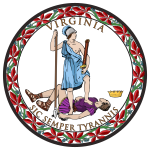The Confederate States Congress was both the provisional and permanent legislative assembly of the Confederate States of America that existed from 1861 to 1865. Its actions were for the most part concerned with measures to establish a new national government for the Southern "revolution", and to prosecute a war that had to be sustained throughout the existence of the Confederacy. At first, it met as a provisional congress both in Montgomery, Alabama, and Richmond, Virginia. As was the case for the provisional Congress after it moved to Richmond, the permanent Congress met in the existing Virginia State Capitol, a building which it shared with the secessionist Virginia General Assembly.
The precursor to the permanent legislature was the Provisional Congress of the Confederate States, which helped establish the Confederacy as a state. Following elections held in states, refugee colonies, and army camps in November 1861, the 1st Confederate Congress met in four sessions. The 1863 midterm elections led to many former Democrats losing to former Whigs. The 2nd Confederate Congress met in two sessions following an intersession during the military campaign season beginning November 7, 1864, and ending on March 18, 1865, shortly before the downfall of the Confederacy.
All legislative considerations of the Confederate Congress were secondary to winning the American Civil War. These included debates whether to pass Jefferson Davis's war measures and deliberations on alternatives to administration proposals, both of which were often denounced as discordant, regardless of the outcome. Congress was often held in low regard regardless of what it did. Amidst early battlefield victories, few sacrifices were asked of those who resided in the Confederacy, and the Confederate Congress and President Davis were in essential agreement.During the second half of the war, the Davis administration's program became more demanding, and the Confederate Congress responded by becoming more assertive in the law-making process even before the 1863 elections. It began to modify administration proposals, substitute its own measures, and sometimes it refused to act at all. While it initiated few major policies, it often concerned itself with details of executive administration. Despite its devotion to Confederate independence, it was criticized by supporters of Davis for occasional independence, and censured in the dissenting press for not asserting itself more often.












